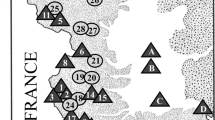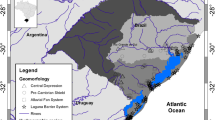Abstract
In Japan, domestic freshwater fish are accidentally introduced into non-native freshwater habitats by human activity, such as the planting of fish. Introduction of the domestic alien fish may have a detrimental effect on native fish inhabitants. However, investigations on the distribution and establishment of such domestic alien fish in non-native river basins and their influence on native fish remains limited. Therefore, we investigated the distribution and establishment of the domestic alien fish Rhynchocypris oxycephalus and its influence on native fish in the Tama River Basin, Japan. Specifically, we used mitochondrial DNA and morphological analyses to clarify the influence of the invasion of this species on the distribution of the closely related fish R. lagowskii, which is native to the river basin. Fish sampled from the upstream section of the main river were mostly R. oxycephalus. This indicates that R. oxycephalus has replaced R. lagowskii in the upstream region. Fish sampled from the downstream section of the main river were mostly R. lagowskii. R. oxycephalus was also captured from agricultural canals linked to the Tama River, and in streams connected to the river via the canals. These observations indicate that the agricultural canal water networks facilitate the invasion of R. oxycephalus to peripheral habitats, such as canals and streams. In contrast, R. lagowskii was found in streams that flowed into the upstream section of the Tama River, with these streams having many large drop structures, indicating that drop structures prevent R. oxycephalus from invading aquatic habitats in these streams.




Similar content being viewed by others
References
Balirwa JS, Chapman CA, Chapman LJ, Cowx IG, Geheb K, Kaufman L, Lowe-McConnell RH, Seehausen O, Wanink JH, Welcomme RL, Witte F (2003) Biodiversity and fishery sustainability in the Lake Victoria Basin: an unexpected marriage. Bioscience 53:703–715
Bureau of Environment Tokyo (2003) 2001 Investigation report on water organisms in the rivers of Tokyo. Bureau of Environment Tokyo, Tokyo (in Japanese)
Bureau of Environment Tokyo (2010) 2010 Red list of threatened species in Tokyo. Available via DIALOG. http://www.kankyo.metro.tokyo.jp/nature/animals_plants/attachement/RL2010TokyoMR.pdf (in Japanese). Accessed 1 Aug 2011
Clement M, Posada D, Crandall KA (2000) TCS: a computer program to estimate gene genealogies. Mol Ecol 9(10):1657–1659
Dowling TE, Childs MR (1992) Impact of hybridization on a threatened trout of the southwestern United States. Conserv Biol 6:355–364
Editorial Board of Tama River History (2001) New Tama River history, Foundation of River and Watershed Environment Management. River Foundation, Tokyo (in Japanese)
Felsenstein J (1985) Confidence limits on phylogenies: an approach using the bootstrap. Evolution 39:783–791
Frankham R, Ballou JD, Briscoe DA (2002) Introduction to conservation genetics. Cambridge University Press, Cambridge
Goldschmidt T (1996) Darwin’s dreampond: drama in Lake Victoria. MIT Press, MA
Higuchi F, Watanabe K (2005) Genetic diversity and hybridization in the cyprinid, Rhynchocypris oxycephalus, from Yokohama central Honshu, Japan. Jpn J Ichthyol 52(1):41–46 (in Japanese with English abstract)
Hosoya K (2000) Cyprinidae. In: Nakabou T (ed) Fishes of Japan with pictorial key to the species, 2nd edn. Tokai University Press, Kanagawa, pp 253–271
ISSG (2004) 100 of the world’s worst invasive alien species. Hollands Printing, New Zealand
Itai T (2001) Rhynchocypris lagowskii. In: Kawanabe H, Mizuno N, Hosoya K (eds) Freshwater fishes of Japan. Yama-kei Publishers, Tokyo, pp 270–273 (in Japanese)
Kimizuka Y (1998) A study on transition and fish fauna of artificial wand-pool in the middle reaches of Tama-gawa River. Environ Eng Res 35:285–293 (in Japanese)
Librado P, Rozas J (2009) DnaSP v5: a software for comprehensive analysis of DNA polymorphism data. Bioinformatics 25:1451–1452
Maehata M (1993) Tendencies of fish assemblage in water areas around Biwako Bunkakan. Annu Rep Biwako Bunkakan 11:43–49 (in Japanese)
Matsui H, Koike Y (2003) Biological evolution and conservation genetics. In: Matsui H, Koike Y (eds) Conservation genetics. University of Tokyo Press, Tokyo (in Japanese)
Moriyama T, Fujisaku M, Mizutani M, Goto A (2006) Influence of upstream migration through newly built fish-ways on fish fauna in an irrigation stream. Trans JSIDRE 245:805–806 (in Japanese)
Nakai K (2002) Fishes. In: Ecological Society of Japan (ed) Handbook of alien species in Japan. Chijinshokan, Tokyo, p 109 (in Japanese)
Nakamura M (1976) Investigation of fish fauna in the Tama River System. In: Tokyu Foundation for Better Environment (ed) Report on natural environment investigation in the Tama River Basin 2nd investigation. Tokyu Foundation for Better Environment, Tokyo, pp 27–74 (in Japanese)
Nishida K (2009) Conservation of freshwater fishes inhabiting haruno-ogawa located in the middle reaches of rivers. In: Mizutani M, Mori A (eds) Conserving habitat of freshwater fishes inhabiting haruno-ogawa, irrigation/drainage ditches, in rice paddies. Gakuhosya, Tokyo, pp 31–62 (in Japanese)
Nishida K, Fujii C, Minagawa A, Senga Y (2006) Research on migration and dispersal range of freshwater fish that reproduce in temporary water area—case study of Mukojima-channel in Hino-city and Fuchu-channel in Kunitachi-city, Tokyo. Trans JSIDRE 244:553–565 (in Japanese with English abstract)
River Bureau of MLIT Japan (2007) 2007 Summary of national census on river environments (in Japanese)
Smith HM (1955) The perspective of species. Turtox News 33:74–77
Takahashi K, Onodera T, Kumagai A (2001) Appearance of largemouth bass and changes in species composition of fish caught by set net at Izunuma and Uchinuma. Miyagi Pref Rep Fish Sci 1:11–18 (in Japanese)
Takai N, Abiko Y, Tsukamoto H, Miura A, Yuasa K, Itoi S, Nakai S, Sugita H, Yoshihara (2012) Species identification of upstream fat minnow, Rhynchocypris oxycephalus and downstream fat minnow Rhynchocypris lagowskii, based on PCR-RFLP of mitochondrial DNA. Ichthyol Res 59:156–163
Tamura K, Peterson D, Peterson N, Stecher G, Nei M, Kumar S (2011) MEGA5: molecular evolutionary genetics analysis using maximum likelihood evolutionary distance and maximum parsimony methods. Mol Biol Evol 28:2731–2739
Thompson JD, Gibson TJ, Plewniak F, Jeanmougin F, Higgins DG (1997) The CLUSTAL-X windows interface: flexible strategies for multiple sequence alignment aided by quality analysis tools. Nucleic Acids Res 25:4876–4882
Tsunoda H, Mitsuo Y (2012) Multiple effects of exotic largemouth bass (Micropterus salmoides) and environmental factors on species richness and composition of pond-dwelling fishes. Aquat Living Resour 25:163–171
Fujita T, Hosoya K (2003) Biochemical and morphological comparison between two Japanese daces, Phoxinus lagowskii steindachneri and P. oxycephalus jouyi in the sympatric sites. Jpn J Ichthyol 50(1):55–62 (in Japanese with English abstract)
Acknowledgments
We greatly appreciate the assistance of the staff of the Water Resource Planning Laboratory and Ethology Laboratory at the Tokyo University of Agriculture and Technology. We would also like to thank especially the staff of the Bureau of Industrial and Labor Affairs, Tokyo Metropolitan Government. This study was supported by a research grant from the Tokyu Foundation for Better Environment, Grant Number 288, and a Grant-in-Aid for Scientific Research (Grant-in-Aid for JSPS Fellows), Grant Number 22·6719. The experiments comply with the current laws of Japan.
Conflict of interest
The authors declare that they have no conflict of interest.
Author information
Authors and Affiliations
Corresponding author
Rights and permissions
About this article
Cite this article
Nishida, K., Koizumi, N., Satoh, T. et al. Influence of the domestic alien fish Rhynchocypris oxycephalus invasion on the distribution of the closely related native fish R. lagowskii in the Tama River Basin, Japan. Landscape Ecol Eng 11, 169–176 (2015). https://doi.org/10.1007/s11355-014-0257-8
Received:
Revised:
Accepted:
Published:
Issue Date:
DOI: https://doi.org/10.1007/s11355-014-0257-8




